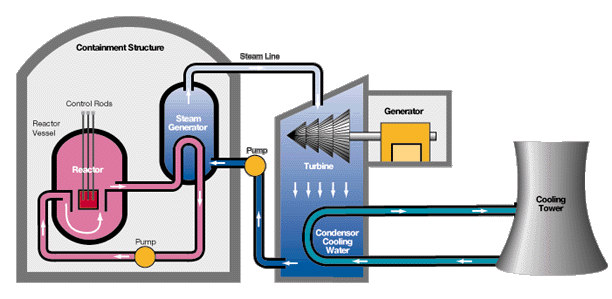
Three Mile Island Event
| 1. | A valve in the condensate system (between the condenser and the pump on the secondary side) failed closed, which reduced the amount of water being supplied to the steam generator; the main feedwater pumps and the turbine tripped within seconds. |
| 2. |
|

| 3. | The reactor continued to heat the reactor coolant. The reactor coolant pumps continued circulating the water to the steam generators, however no heat could be removed by the secondary side since there was no water in the steam generators. The reactor coolant system started to heat up. |
| 4. | Pressure rose in the reactor cooling system until the reactor shutdown. A power operated relief valve opened in the line between the pressurizer and the quench tank.. This valve failed to reclose when it was supposed to - after pressure dropped below the setpoint for closure. This relief valve continued to discharge to the quench tank. The fact that the valve was open allowed steam to continue discharging to the quench tank. Pressure dropped in the reactor cooling system because the valve was still open (however, due to poor control board design and a failure to indicate the valve position properly, the operators did not know the valve was open). The quench tank has a rupture disc that opens at about 10-12 pounds per square inch. When this happened, the steam was released to the containment. |
| 5. | The pressurizer is normally at about 650F. As pressure dropped in the reactor cooling system, eventually water in the upper-most area of the reactor (about 10-15 feet above the fuel) flashed to steam. The indicated water level in the pressurizer stayed high (the relationship between the pressurizer and the reactor was like a manometer). |
| 6. | The operators turned off the emergency water injection pumps because they thought there was still water in the pressurizer. |
| 7. | The operators turned off the reactor cooling pumps because they were concerned about damage due to potential excessive vibration.. This resulted in a steam void forming in the reactor coolant loop. In addition, a steam bubble formed in the upper part of the reactor above the fuel. Eventually as the fuel heated, this void expanded. Eventually, the fuel cladding material overheated. It is likely that some hydrogen was produced by a chemical reaction between the zircaloy clad and the steam in the reactor. In addition, the hydrogen normally present in the reactor cooling system (used to reduce the presence of oxygen and subsequent corrosion in the system) was released to the containment through |
| 8. | At one point, containment pressure rapidly spiked to 28 pounds per square inch; then rapidly dropped. This was most likely due to the chemical reaction of hydrogen with the oxygen in the containment. |
| 9. | Water was added to the reactor cooling system and the level raised in the pressurizer until cooling of the reactor was assured. |
|
1. Reactor 2. Once-through Vertical Steam Generator 3. Pressurizer 4. Quench Tank or Pressurizer Relief Tank Green identifies the Reactor Coolant System flow path. Blue on right shows feedwater going to and in the secondary side of the steam generator Blue in bottom of containment shows containment sump. Blue in upper left shows the Quench Tank. Note steam leaving. |
Courtesy KWU |
|
What was the maximum radiation exposure offsite?
Studies conducted indicate that the maximum potential offsite radiation exposure likely was 83 millirem. An actual individual located on a nearby island is believed to have received at most 37 millirem. Extensive studies by federal agencies led to these conclusions and to an estimate that one excess cancer fatality due to the accident could be expected over a 30 year period.
What Good came from the TMI Event?
Several thorough investigations occurred - the most important was that conducted by the Kemeny Commission which was appointed by President Carter and resulted in a number of recommendations. Improvements were needed in the follwing areas:
The electric utilities recognized their responsibilities. An industry self-assessment group was formed - the Institute of Nuclear Power Operations. This organization, based in Atlanta, serves several functions:
All electric utilities expanded significantly the training conducted for personnel who work at and support nuclear plant operations. This included establishing the National Nuclear Academy which accredits the plant training programs in 10 areas. Also, all utilities purchased simulators for training personnel who work in the main control room.
The NRC also took decisive action imposing a number of changes related to equipment, analysis, practices, and personnel. The NRC conducted their own self examination referred to as the Rogovin study. Two major documents were issued - NUREG-0696 and NUREG-0737. Equipment changes included monitoring instrumentation capable of withstanding severe accidents and hydrogen recombiners. Analysis involved small break loss of coolant events. Practices changed included upgrading of emergency operating procedures and development of emergency plans. Personnel-related changes involved upgrading of training and qualification requirements and a requirement to have a degreed shift technical advisor assigned to each shift to evaluate abnormal conditions.
The Federal Emergency Management Agency, in conjunction with the NRC, developed criteria for classifying emergencies, emergency planning, and evacuation plans.
Other TMI Links
Copyright © 1996-2006. The Virtual Nuclear Tourist. All rights reserved. Revised: December 24, 2005.